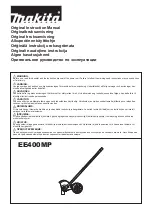
Introduction
Frog 2 Operating Manual – Issue 4.3
Page 9
Cues, Cue Stacks and Playbacks
The desk allows you to record cues, for use in any of the 1000 user programmable cue
stacks. Each cue has a number, name (optional), trigger, a wait time (auto cues) and a set
of delay, and fade times. It is possible to give each parameter of each fixture their own
individual fade and delay times.
The desk provides 100 pages of playbacks, each page containing 10 playbacks. The 1000
cue stacks are mapped 1:1 with the 100 pages of playbacks.
Groups
The desk provides 200 user definable groups. Automatic groups for each fixture type in
the schedule can be generated from the Setup area, if required.
Palettes
The desk provides 200 user programmable palettes for each of the four attributes (Colour,
Beamshape, Position and Effects).
User Definable Faders (UDF)
The desk provides 100 pages of 10 User Definable Faders, with associated ‘flash’ buttons.
The User Definable Faders may be assigned to Groups, Cues, single fixture parameters or
channel data. They can also be assigned to Time, Override or Virtual Playback Master
Fader functions.
User Definable Keys (UDK)
The desk provides 100 pages of 20 User Definable Keys. The User Definable Keys may
be assigned to Groups, Fixtures, Palettes, Effects, Cues, or channel data.
Output Processing on the Frog 2 Desk
The Frog 2 has two distinct channel types:
Intensity
channels and
Attribute
channels
(colour, beam and position).
The main difference is that Intensity channels can be flashed, are mixed with their source's
Master Fader and the GRAND MASTER, and can have distinct Fade Up and Down times.
When you play back a cue, park a channel, or manually manipulate a channel in the
Program Window, you give ownership of the channel to that specific area of the desk.
When a channel is owned, the programmed value (or series of values, if it is defined as a
chase or effect) is output. However, the previous owner(s) are not forgotten, and go into in
a history list.
When a cue is released, it loses it's places in the history, whether it currently owns them or
not. The most recent owner in the history will then regain ownership, and hence control the
output of that channel.
If a channel is not owned by any source, then it will output zero for an Intensity channel, or
it's default value for an Attribute channel.
Summary of Contents for FROG 2
Page 1: ...FROG 2 OPERATING MANUAL...
Page 2: ......
Page 76: ...Setup Page 76 Frog 2 Operating Manual Issue 4 3...
Page 80: ...Groups Page 80 Frog 2 Operating Manual Issue 4 3...
Page 144: ...Palettes Page 144 Frog 2 Operating Manual Issue 4 3...
Page 152: ...Effects Page 152 Frog 2 Operating Manual Issue 4 3...
Page 178: ...Technical Specification Page 178 Frog 2 Operating Manual Issue 4 3...
Page 183: ......










































